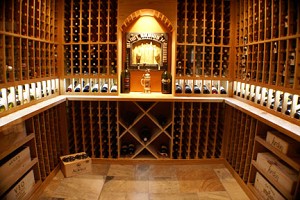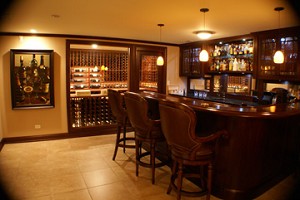“Liquid Assets” – A Perfect Cellar For Your Palate
By Leslee Miller
If you’ve found yourself with a number of wine bottles ‘stashed’ in a corner of your basement in some sort of make shift fashion you’ve created for your growing obsession of grape juice, you spend parts of your day surfing online wine stores or auctions for rare wine gems, or you’re starting to sneak in ‘small’ wine shipments past your spouse to add to your pile…chances are, you’re a wino.
While the word ‘wino’ once carried a negative connotation, today the word absolutely acts as a complimentary label to those obsessed with the grape juice fermented beverage, better known as: WINE. From your average weekend wine warrior to your serious collector, the growing number of folks infatuated with the stuff is growing.
Many, who eventually find themselves in a position of needing a way to organize or store the treasures they’ve come to hoard. From the ‘build it yourself’ online racking systems to a custom designed room specifically created for one’s collection, there are a number of options one can take when preparing to secure your growing wine investment.
One of the first questions clients regularly ask me is ‘What’s a good size?’ As a certified sommelier and owner of consulting wine firm, I find this to be the very first question people ask when I consult on cellar management build-outs. Determining the size of your cellar starts first by laying out your real interest in the subject. The path to really figuring this out for an individual or a family comes first with a personalized interview process from our end.
Some of those questions might include:
1.) How do you enjoy wine (from an educational stand-point, or casually)? Do you entertain with wine? Do you collect wine for investment purposes?
2.) Do you plan to expand your collection? Are you willing to extend beyond the regions that you currently collect and broaden your wine knowledge?
When Amusée comes in to help you lay out your wine collection, we look at your project from top to bottom. We feel that the process evolves into more of a partnership that imbibes the relationship you want to have with your current collection and how you plan to expand it. I like to think of it as ‘palatizing’ your wine needs, which is why I start first with the interview questions I laid out above.
Following our introduction, I then bring a full tasting to you to enjoy with a handful of friends and family, so that I can get a gist of what your palate enjoys and where I might be able to help you expand your love for wine when it comes to styles and varietals that lie outside your general drinking specs.
From here, the client/sommelier relationship continually builds over a number of meetings as we build upon your current inventory, which also includes providing the tools needed for managing your current bottles (tracking system, food pairing notes, etc.). In the end, you windup with an inventory that is not only managed from a standpoint of how you currently enjoy wine, but how you plan to build from that as you potentially step into a larger collection.
While styles, varietals and regions are all very important pieces to understand and organize when you first start to analyze your collection, however, you also want to pay very special attention as to how you will plan to protect your ‘liquid assets’.
• First, you want to create a temperature-controlled environment (52-56°F and 70% humidity), with virtually no natural light, draughts, vibration or variation to temperature.
• Next, consider what you current hold in stock from a bottle perspective, and how much larger you’d like to take that collection as you will need a space that will be able to hold what you have.
*Remember: Bigger is not always better.
(*The larger the collection can sometimes require drinking a lot more than what most can keep up with. If you take a look at your current stock you might just find that many bottles have already expired. Just because a bottle is French or Italian, doesn’t mean that it will be able to age the longest. Most of the rules to properly aging wine has a lot to do with not only the region, but the price-point of the wine, the house from which it was made and the vintage that produced it.)
And lastly, and sometimes the most fun part of the process, is building out the space you plan to use for cellaring. As I originally mentioned, there are a number of do-it-yourself kits that allow you to piece together racking that best fits your current space (from Costco to Wine Enthusiast). However, you may have additional space in your home or an area that you’d like revamped to build an actual cellar.
Larger spaces are ideal if you entertain a lot with wine in your home. In this case, hiring a professional cellar builder is really the key to having it done correctly. One builder I work with regularly, is architect Andrew Hightower of Foxwood Cellars, who does an outstanding job building custom made cellars that are meant for every style of wine drinker.
From drinking to storing, wine collecting actually requires a whole lot more work than folks expect. Making sure you have the right tools or information needed for protecting your liquid dollars sometimes means investing in a proper system or space so that your tasty grape juice doesn’t eventually become very expensive vinegar.
Photos Courtesy Foxwood Cellars
Cellar #1 Facts:
– Oak with hand-rubbed oil finish
– Tasting room and walk in wine cellar
– 1,100 bottles
– LED lighting and pull-out case shelves
Cellar #2 Facts:
– 2,000 bottles
– Double deep case storage below counter on pull out slides
– Brazilian Cherry wood with hand rubbed oil natural oil finish
– Magnum bottle display

Wine Cellar #1



